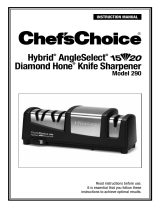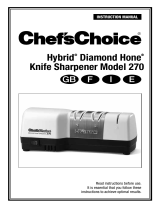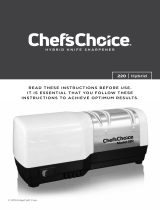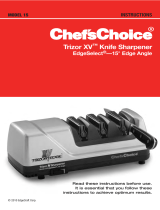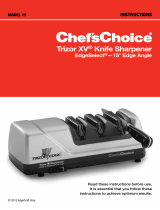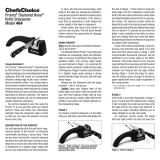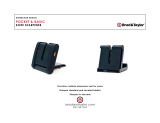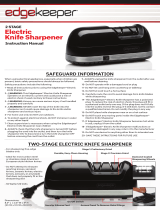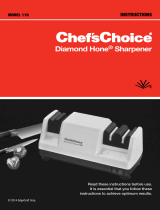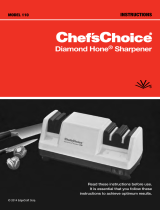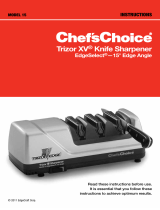Page is loading ...

INSTRUCTION MANUAL
Hybrid
®
Diamond Hone
®
Knife Sharpener Model 250
Read instructions before use.
It is essential that you follow these
instructions to achieve optimal results.

2
IMPORTANT SAFEGUARDS
When using electrical appliances, basic safety precautions should always
be followed including the following:
1. Read all instructions. For your safety, every user should read this manual.
2. To protect against electrical hazards, do not immerse the Chef’sChoice
®
Hybrid
®
sharpener in water or other liquid.
3. Make sure that only clean knife blades are inserted in Model 250.
4. Disconnect the appliance from its power source when not in use, before cleaning,
during service and when replacing parts.
5. Avoid contacting moving parts.
6. Do not operate any appliance with a damaged cord or plug or after the appliance
malfunctions, or is dropped or damaged in any manner.
U.S. customers: You can return your sharpener to EdgeCraft’s factory for service where
the cost of repair or electrical or mechanical adjustment can be estimated. When the
electrical cord on this appliance is damaged, it must be replaced by the Chef’sChoice
®
factory or other qualified service to avoid the danger of electrical shock.
Outside U.S.: Please return your sharpener to your local distributor where the cost of repair
or electrical or mechanical adjustment can be estimated. If the supply cord of this appliance
is damaged, it must be replaced by a repair facility appointed by the manufacturer because
special tools are required. Please consult your Chef’sChoice
®
distributor.
7. CAUTION! This appliance may be fitted with a polarized power plug (one blade is wider
than the other). To reduce the risk of electric shock, this plug will fit in a polarized outlet
only one way. If the plug does not fit fully in the outlet, reverse the plug. If it still does not
fit, contact a qualified electrician. Do not modify the plug in anyway.
8. The use of attachments not recommended or sold by EdgeCraft Corporation may cause
fire, electric shock or injury.
9. The Chef’sChoice
®
Hybrid
®
sharpener is designed to sharpen American, European,
and Asian style knives as described in following sections. Do not attempt to sharpen
scissors, ax blades or any blade that does not fit freely in the slots.
10. Do not let the cord hang over edge of table or counter or touch hot surfaces.
11. When in the “ON” position (Red flash on switch is exposed when “ON”), the
Chef’sChoice
®
sharpener should always be on a stable countertop or table.
12. WARNING: KNIVES PROPERLY SHARPENED ON YOUR Chef’sChoice
®
Hybrid
®
SHARPENER WILL BE SHARPER THAN YOU EXPECT. TO AVOID INJURY, USE AND HANDLE
THEM WITH EXTREME CARE. DO NOT CUT TOWARD ANY PART OF YOUR FINGERS, HAND
OR BODY. DO NOT RUN FINGER ALONG EDGE. STORE IN A SAFE MANNER.
13. Do not use outdoors.
14. Appliance is not intended to be used or cleaned by children or persons with reduced
physical, sensory or mental capabilities or lack of experience and knowledge of the
hazards involved.
15. Do not use honing oils, water or any other lubricant with the Chef’sChoice
®
Hybrid
®
sharpener Model 250.
16. For household use only.
17.
SAVE THESE INSTRUCTIONS.

3
Congratulations on your selection of
the Chef’sChoice
®
Hybrid
®
Diamond Hone
®
Model 250!
The three stage Hybrid
®
Diamond Hone
®
Model 250 is manufactured by EdgeCraft — the
home of Chef’sChoice sharpeners — the World’s Leader in Cutting Edge Technology
®
. This
sharpener combines advanced electric and manual sharpening techniques to create an
effective triple bevel durable cutting edge on virtually all of your knives. The cutting edge,
finely honed to razor sharpness can be resharpened quickly whenever necessary. Commonly
the edge can be resharpened in Stage 3 without the need to turn on the electrical power.
You will be pleased to see how easy the Hybrid
®
is to use. Read and follow the instruction
carefully. Keep the sharpener close at hand so that you can enjoy the pleasure of sharp
knives every day.
DESCRIPTION OF THE
CHEF’SCHOICE HYBRID
®
DIAMOND HONE KNIFE SHARPENER MODEL 250
This advanced Hybrid
®
Diamond Hone Sharpener has two motor driven sharpening Stages 1
and 2, followed by a single manual honing and polishing Stage 3.
In Stage 1, motor-driven, highly effective diamond abrasive disks remove the dull edge
and create a sharp fully faceted edge at the conventional 20 degrees on each side of the
blade. In Stage 2 similar technology is used with finer diamond abrasives at a slightly larger
angle to create a small second bevel along the edge. This two step sharpening process
leaves a stronger – arch shaped profile along the edge for greater strength and durabil-
ity. In Stage 3 the edge is lightly honed and polished to create a razor sharp Trizor edge of
increased perfection, sharpness and durability.
In Stage 1 there are two knife-guiding slots. These are referred to as the left and right
slots of Stage 1. Likewise in Stage 2 there are two guiding slots, left and right that sharpen
alternately the right and left side of the blade’s edge. Stage 3 has only one guiding slot that
centers the blade in a manner so that both sides of the edge are honed simultaneously. When
sharpening in Stages 1 and 2, always follow an alternating pattern of sharpening in the right
and left slots. This pattern insures that both sides (facets) of the edge are sharpened alike for
better control of the cutting action of blade.
This three stage design provides the ultimate in versatility of the knife edge so that you
can tailor the edge geometry to your cutting needs. For example you may find it preferable
to leave a slight microscopic tooth structure along the knife edge for cutting fibrous foods.
Likewise for slicing gourmet presentations you may prefer a highly perfect and polished
edge. As described later in more detail, the Model 250 Hybrid gives you this flexibility.

4
USING THE MODEL 250 SHARPENER
Note: Always clean your knife before sharpening in the Hybrid
®
! For your safety, keep your
fingers clear of the blade edge at all times.
You will find that the Hybrid
®
can create and maintain a very sharp and effective edge
on all your conventional fine edge and serrated cutlery. The primary edge facets are each
formed in Stage 1 at a nominal 20 degrees on each side of the edge, which results in a total
primary edge of 40 degrees. Stages 2 and 3 create a second and third bevel at slightly larger
angles leaving a strong triple beveled edge structure. Always use the sharpener with the
stage numbers 1, 2 and 3 facing you.
STAGE 1
To sharpen, place the sharpener on the table gripping it securely with your left hand. Push
on the power switch. Insert the knife blade, (Figure 1) near its handle, into the far left slot of
Stage #1 and allow the left face of the blade to rest on the left face of the slot as you pull the
knife toward you. The knife edge should be in sustained moving contact with the internal dia-
mond abrasive coated disk. Only light downward force will be necessary as you pull the blade
toward you. Listen carefully to insure your knife maintains good contact with the rotating
diamond disk. Take about 5 seconds to make each pull if you have a six inch (6”) long blade.
Increase the time of each pull for longer blades or decrease the time for shorter blades.
Make one pull of the blade in the left slot as described above and then repeat the same
procedure in the adjacent (right) slot of Stage 1. As you pull the knife thru the right slot,
(see Figure 2), hold the right face of the knife against the slanted right face of the slot. If
your knife, before sharpening, is not very dull you will find that only about 5 pairs of pulls,
alternating in the left and right slots of Stage 1, will be sufficient to put a keen edge on the
Figure 1. Inserting the blade in the left slot of the
Stage 1. Alternate individual pulls in left and right slots.
Figure 2. Inserting the blade in the right slot of Stage 1.
Alternate pulls in left and right slots.

Burr
Figure 3. Develop a distinct burr along knife edge
before sharpening in Stage 2 or 3. Burr can be detected
by sliding finger across and away from the edge.
Caution! See text.
Figure 4. Inserting the knife in left slot of Stage 2.
Alternate individual pulls in left and right slots.
5
blade. However, if the knife is initially very dull you may find that 10 or more alternating pairs
of pulls in the left and right slots of Stage 1 will be needed the first time as you reshape and
sharpen the old edge. Always pull the blade toward you. Never push the blade away from
you when using Stage 1. Before leaving Stage 1 it is important to examine the knife edge to
insure there is a small burr along one side of the edge.
Figure 3 illustrates how to check for the burr. Proceed as follows: If your last sharpening
pull was in the right slot there should be a small burr on the right side of the blade edge. If
the last pull was in the left slot there should be a small burr along the left side of the edge. If
there is no burr make another pair of pulls and again check for a burr. Repeat making pairs
of alternating right and left pulls until you create a small burr along the edge. (Sometimes it
is easier to create the burr if you pull the blade slower.) Make another single pull and confirm
there is a burr along the edge after each pull. Only then are you are ready to sharpen in
Stage 2.
STAGE 2
Once you have confirmed that a burr was formed in Stage 1, you are ready to sharpen the
knife in Stage 2.
Proceed to sharpen in the left and right slots of Stage 2 which have finer abrasive and
sharpen at a slightly larger angle than Stage 1 in order to create a small second bevel ad-
jacent the knife edge.
You will likely find that only 1-2 pairs of pulls in Stage 2 will be sufficient to create a
small burr along the edge. Always sharpen alternately in the left and right slots of Stage 2,
taking about 5 seconds each pass for a 6” blade (see Figures 4 and 5). Take longer for longer
knives, and less time to pull shorter blades through the slots. The burr will be slightly smaller

6
than you experienced in Stage 1. Pull slower if needed to develop a detectable burr before
moving to Stage 3. You will notice that the edge developed in Stage 2 is sharper than the
edge formed in Stage 1.
Do not move to Stage 3 (manual) until you are confident that you detect a burr after Stage 2.
Once a burr is detected, you can make a pair of faster pulls in Stage 2 to remove the burr
and minimize the time you will need to hone and polish the edge in Stage 3.
STAGE 3
Since Stage 3 is a manual (non-electric) honing stage you can turn off the power switch. If
the knife is fully sharpened in Stage 2 only 5 to 10 back and forth strokes will be needed in
the single slot of Stage 3 (the far right slot, see Figure 6) to hone a small third bevel along the
edge. It should now cut paper smoothly allowing you to make straight or curved cuts easily.
For optimum results in Stage 3 center the blade within the slot width and keep the length
of the blade aligned with the center-line of the slot as you move the blade back and forth in
the slot without lifting. Apply only a light downward pressure on the blade as you sharpen
in Stage 3. For optimum results make smooth consistent strokes while maintaining the light
downward pressure. The finished edge will be very sharp and burr free.
OPTIMIZING THE KNIFE EDGE FOR YOUR CUTTING TASKS
The novel three stage design of the Model 250 Hybrid offers you the opportunity to tailor your
knife edge to the cutting task at hand.
For example, if you wish to retain greater “bite” of your knife edge you will find that the
edge resulting from Stage 1 sharpening or Stage 2 sharpening may be ideal. This might be
ideal for cutting steaks or roasts for example. To optimize the edge using only Stage 1, follow
the instructions for Stage 1 and make one (1) pair of very fast pulls (1-2 seconds per pull)
after you establish the burr. The fast pulls will remove the burr but leave you a micro-serrated
edge ideal for such use.
You can also evaluate the edge created following the above instructions after using both
Stage 1 and 2, followed by one pair of fast pulls in Stage 2. This will leave a finer micro-
serrated edge than that created by just Stage 1. You can evaluate such modified procedures
Figure 5. Inserting the knife in right slot of Stage 2.
Alternate individual pulls in left and right slots.
Figure 6. Knife in Stage 3. Use back and forth sharpen-
ing strokes with modest downward pressure. See text.

7
to suit your preferences. The finest edge, best for gourmet presentations will be obtained by
following the complete procedures of Stages 1, 2 and 3.
RESHARPENING THE KNIFE EDGE
To resharpen follow the procedure for Stage 3 described above, making 10-20 complete
back and forth stroke pairs while maintaining recommended downward pressure. Then test
the edge for sharpness. If necessary resharpen again but first use Stage 2 followed by back
and forth pairs of strokes in Stage 3. Generally you should be able to resharpen several times
using only Stage 3 before having to resharpen in Stage 1.
SERRATED BLADES
Serrated blades can be sharpened in Stage 3 (see Figure 7). Center the blade in the slot of
Stage 3 and make twenty-five (25) back and forth pairs of strokes.
Examine the edge and if necessary make another 25 full stroke pairs. Test the blade for
sharpness. If the blade to be sharpened is very dull, first make two fast pairs of pulls — al-
ternating right and left slots in Stage 2 and then make twenty-five (25) paired strokes (back
and forth) in Stage 3. Because of its nature, a serrated knife will not ever appear as sharp or
cut as smoothly as a straight edged blade. Caution: Do not make many strokes in Stage 2, or
you will remove too much metal from the teeth of the serrated edge.
ASIAN BLADES
The Hybrid
®
which sharpens at a primary angle of 20 degrees, can sharpen double faceted
Asian blades such as the Santoku which is traditionally sharpened at 15º. However, for opti-
mum results with all Asian blades we recommend a 15º sharpener such as the Chef’sChoice
®
Electric Models 15XV or 1520 as the preferred choice for all Asian style blades.
Do not sharpen in the Hybrid
®
any single sided, single faceted Asian Kataba knives, such
as the traditional sashimi styled blade that is commonly used to prepare ultra thin sashimi.
Stage 3 sharpens simultaneously both sides of the cutting edge while the sashimi knives are
designed to be sharpened only on one side of the blade. The Chef’sChoice electric sharp-
eners listed in the previous paragraph will correctly sharpen these single sided knives.
CERAMIC KNIVES
The Hybrid
®
is not recommended for ceramic knives.
Figure 7. Serrated knife in Stage 3.

8
Assembled in the U.S.A. www.chefschoice.com
This product may be covered by one or more EdgeCraft patents and/or patents pending as
marked on the product.
Chef’sChoice
®
, EdgeCraft
®
, Diamond Hone
®
and Hybrid
®
are registered trademarks of
EdgeCraft Corporation, Avondale, PA.
Conforms to UL Std. 982 Certified to CAN/CSA Std. E60335-1/4E
© EdgeCraft Corporation 2014 Printed in China.
E14 C208204
EdgeCraft Corporation
825 Southwood Road, Avondale, PA 19311 U.S.A.
Customer Service (800) 342-3255 or 610-268-0500
SCISSORS
Do not attempt to use the Hybrid
®
to sharpen scissors. EdgeCraft does manufacture
special sharpeners designed just for scissors.
BRANDS OF KNIVES
The Hybrid
®
will put an excellent edge on all conventional metal Euro/American and
Santoku style knives regardless of brands, including Henckels, Wüsthof, Sabatier, Lamson
and Goodnow, Global, Russell Harrington, Chef’sChoice, Messermeisser, Forshner, Mundial,
Cuisinart, Kitchen Aid, Shun and many, many more.
TEST FOR SHARPNESS
To test for sharpness and cutting ability of your fine edge knives, hold a sheet of paper
vertically by its upper edge and carefully cut down through the sheet a small (but safe)
distance from your fingers. A sharp edge (on a straight edge blade) will cut smoothly without
tearing the paper.
Alternatively try cutting a tomato. The knife should penetrate the skin of the tomato and
cut through it on the first pull without applying significant force to the knife.
MAINTENANCE
• TheexterioroftheHybrid
®
can be cleaned with a damp soft cloth.
• Periodicallyshakeoutanddisposeofthemetalsharpeningdustbyinvertingthe
sharpener and lightly tapping it onto a newspaper, paper towel, or other paper sheet.
• Nooilsorotherlubricatingliquidsarenecessarywiththissharpener.
/
